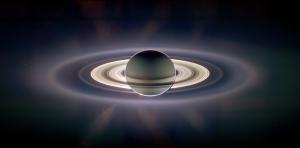Blog
Ancient Rings
21 August 2014
 NASA/JPL/Space Science Institute
NASA/JPL/Space Science InstituteSaturn is everyone’s favorite ringed planet. It’s ring system is both complex and extraordinarily bright. Just why it is so bright has been a bit of a mystery. It’s brightness is due to the fact that the rings are composed almost entirely of water ice, and the fact that there isn’t a great deal of dust in the rings. Because of this, it was once thought that Saturn’s rings were generally young. If the ring system were old, one would expect it to darken over time as dust and other debris from the solar system accumulate over time. This also agreed with the idea that such a complex ring system would likely be unstable over millions of years.
Since then we’ve come to understand how complex interactions can occur within Saturn’s rings, and computer simulation have shown that complex ring systems can be stable over billions of years, and observational evidence has even shown Saturn’s rings can withstand cometary or asteroid bombardment. Spectral analysis of the rings show that its composition varies with distance, just as the moons of Saturn do, and this suggests the ring system formed around the same time as Saturn itself. But if Saturn’s rings are indeed old, how is it that they remain so bright? We’ve also observed that ice particles within the rings are continually clumping and breaking apart, which would help keep the rings looking “fresh”, but this doesn’t seem to be enough to keep the rings bright over billions of years.
Now new results announced at the University of Colorado may have solved the mystery. They analyzed the number dust particles striking the Cassini probe as it orbits Saturn. By determining the trajectories of these particles, the team could determine the rate at which material from the solar system is captured by Saturn’s rings. What they found was that the accumulation rate is smaller than previously supposed by a factor of 20. This means Saturn’s rings could remain bright for much longer than we had thought. Based upon the accumulation rate, the team estimated Saturn’s rings to be about 4.4 billion years. This is within the range of Saturn’s formation.
So it seems that Saturn has always been a ringed planet.